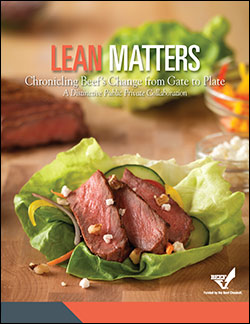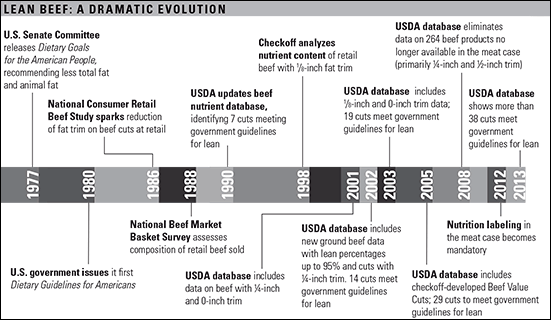An Evolution of Lean Beef
In the mid-1980s the beef industry started a “War on Fat.” Today, the meatcase is a “sea of red.”
 Responding to its market, the beef industry began making important changes in both perceived and actual nutritional properties of its products nearly 40 years ago. Those changes and the resulting impact they have had in marketing beef are more significant than most producers realize.
Responding to its market, the beef industry began making important changes in both perceived and actual nutritional properties of its products nearly 40 years ago. Those changes and the resulting impact they have had in marketing beef are more significant than most producers realize.
The industry’s first wake-up call came in 1977 when the U.S. Senate Select Committee on Nutrition and Human Needs released the Dietary Goals for the American People. Among other things, that document recommended Americans decrease consumption of red meat in favor of poultry and fish.
“All of a sudden, red meat became demonized,” said Jeff Savell, university distinguished professor at Texas A&M University, who has been involved in beef industry research since the late 1970s. “We found people’s attitudes were sometimes based on ancient data.”
Savell and colleagues, in fact, found the biggest impediment to establishing dietary recommendations at the time was faulty product information. For instance, Savell says that up until 1986, data for the beef porterhouse steak showed the cut had more than 42% fat — and this information was based on just a few heifers from the 1950s.
“It was a horrible lag in data,” Savell said. “We had outdated information for decades. Furthermore, we needed to define the concept of lean beef.” Compounding that was the fact the industry was actually marketing beef with too much fat — “dinosaur cuts, as we look at it today,” he says.
With the power of Congress against it, and with consumers increasingly viewing beef as unhealthful, the industry knew it had a fight on its hands. Starting in earnest in the mid-1980s and with a battle cry of “War on Fat,” the industry effort intended to find a way of incorporating beef into a new American consciousness focused on fat.
It’s important to note the war was not waged against Congress or consumers.
“At the time, just about every man over 50 years old visiting his doctor was being told to quit eating red meat,” says Eric Hentges, who was director of nutrition research at the National Live Stock and Meat Board from 1986 to 1995. “We took more of a ‘fit don’t fight’ approach to attacking the issue.”
The results of this war were impressive by any standard.
Since the late 1970s, the industry has demonstrated a 44% reduction in available fat (from 13% to 7%) and a 29% reduction in saturated fat contributed by beef per capita (from 13% to 9%). Furthermore, greater than 65% of whole-muscle beef cuts sold at retail today meet government standards for lean, and 17 of the top 25 most popular cuts sold at retail (including sirloin steak and tenderloin) are lean.
Since the 1980 Dietary Guidelines for Americans were issued, external fat on retail beef cuts has decreased by 81%. Retail data show that sales of 90% or greater lean ground beef increased by 25% between 2008 and 2013.
All hands on deck
The gate-to-plate effort to increase leanness involved every segment of the beef chain — cattle ranchers and farmers who raised leaner animals, packers and processors who closely trimmed beef cuts, supermarkets and restaurants that offered a growing number of lean beef cuts to consumers, and researchers who made sure accurate data were used in calculating what was actually in the products. Also playing a critical role was the Beef Checkoff Program that helped fund much of the research and many of the efforts to get information into the right hands.
“It was the perfect storm,” said Savell. “The need for good information came at the same time as the availability of funding. Without the checkoff, it would not have been done.”
Hentges agrees, saying “without the checkoff, we wouldn’t have had the resources to go forward.”
“Every pivotal point in this journey has had a checkoff element,” says Shalene McNeill, registered dietitian and executive director of human nutrition research at the National Cattlemen’s Beef Association (NCBA), a beef checkoff contractor. “For instance, checkoff work led to collaboration that updated the entire gold-standard nutrient database for beef.”
The Nutrient Database Improvement initiative, in fact, was a unique public-private partnership between cattle producers through their beef checkoff and the government, which established the database. The USDA’s National Nutrient Database for Standard Reference, or SR, has been in place for 115 years, and is the official source for food composition information.
Through this initiative the checkoff has been able to update the nutrient data for one of America’s favorite foods in the official database used by nutrition professionals, media, marketers, government agencies and others. It’s part of an assurance to consumers that the information they’re getting to make dietary choices is accurate and complies with public health recommendations.
Industry meetings about database changes involved USDA staff, which was an enormous benefit, according to Hentges, who is now executive director of the International Live Science Institute (ILSI), North America. “As soon as the data came in, it became their data,” he says. “We had the luxury of using data to get ourselves out of a hole.”

With information in hand, the beef industry made a huge push through its checkoff program in the 1980s and 1990s to reach out to health professionals. For instance, a program with state beef councils and the American Dietetic Association (now the Academy of Nutrition and Dietetics) starting in the late 1980s and continuing today provides seminars to local and state academy groups on nutrient density and the new lean data.
“The data was accurate and believable, and the program very well-received,” says Hentges. “I think we laid a pretty solid foundation.”
From a production and processing standpoint, the key milestone was a major checkoff-funded National Consumer Retail Beef Study in 1986 that demonstrated consumers would buy more beef, and pay more for it, if they were offered a leaner product. “That was probably my ‘aha’ moment,” says Savell.
At that time retail beef trim was about 0.5 inches of external fat. The information from the study created a domino effect in the retail industry to reduce external fat on retail cuts, Savell said, with one retailer trying to outdo the other when it came to closer trim.
The move by retailers to reduce fat trim led to increased efforts by packers to reduce the amount of fat going into the back of the store, according to Clay Burtrum, a cow-calf producer from Stillwater, Okla., and chairman of the checkoff’s Nutrition and Health Committee. Burtrum worked in a retail meat department for about eight years early in his career and says in 1992 fat would be trimmed extensively before cuts were placed into trays. Today, he says, that step isn’t usually necessary.
It also was being supplemented by developments at the production level. Burtrum says on his farm, “we select for different traits, matching attributes of a bull with the dam, figuring out which pasture those animals will run on, and evaluating other options. It really is a pasture-to-plate process.”
The results were demonstrated by a checkoff-funded National Beef Market Basket Survey in 2005, which found that overall fat thickness for the cuts in individual store packages had been reduced to an average of .09 inches, 81% less than it had been just 25 years earlier.
“When you go to the meatcase today, it’s a sea of red,” says Savell. “There is just no visible fat. Over time, we have seen a redefinition of lean.”
Editor’s Note: This article is from the Cattlemen’s Beef Board.






